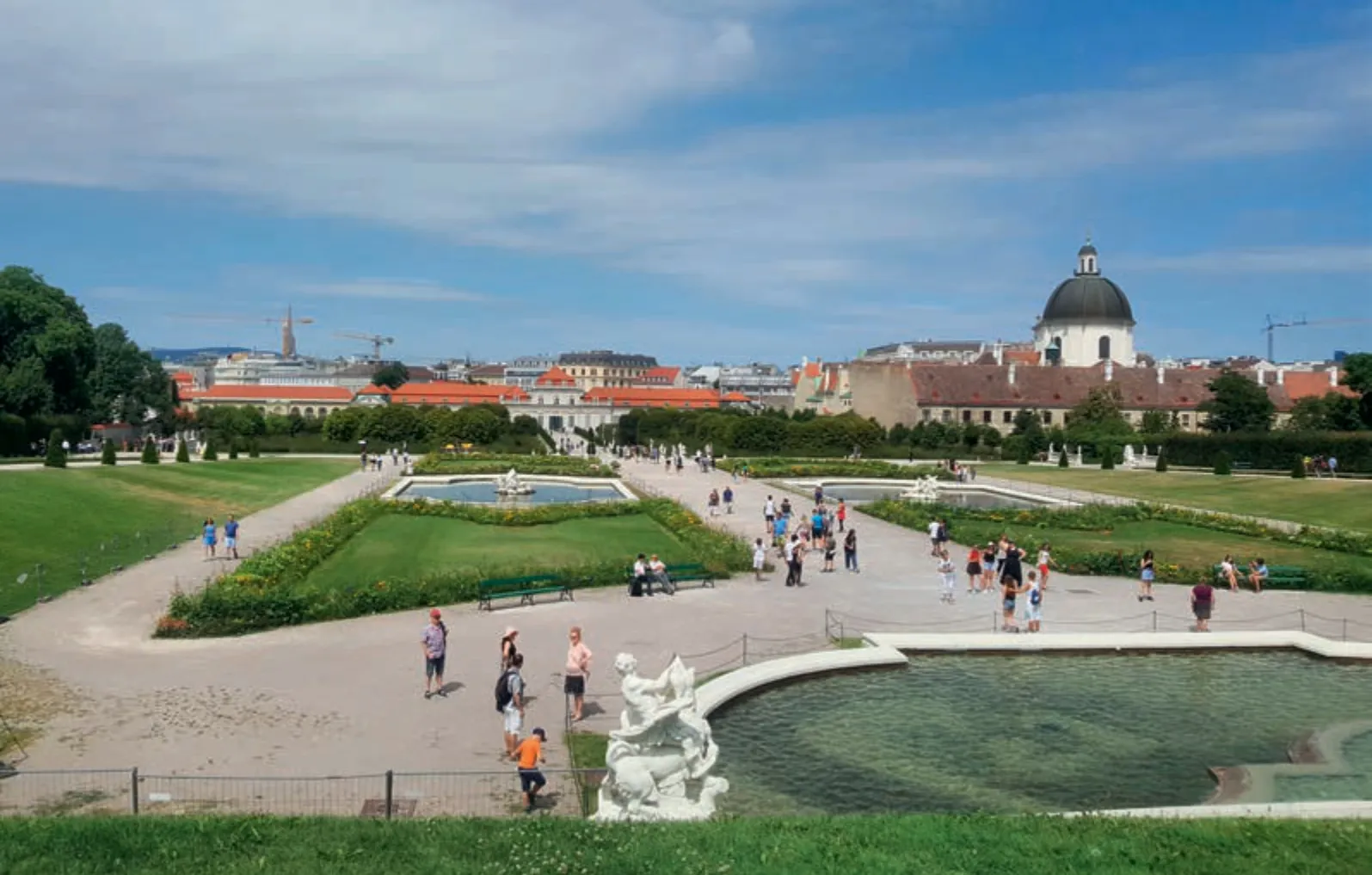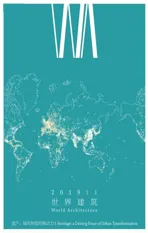遗产影响评估在世界遗产地保护中的实际作用:科隆大教堂和维也纳城市历史中心
2019-11-26巴哈拉克塞耶达什拉菲BaharakSeyedashrafi
巴哈拉克·塞耶达什拉菲/Baharak Seyedashrafi
徐知兰 译/Translated by XU Zhilan
1 世界文化遗产和城市发展
在最近发布的 《联合国2030 年可持续发展议程》文件中,第11 个目标提出呼吁:“建设包容、安全、有抵御灾害能力和可持续的城市和人类住区”;在这个目标下的第11.4 项任务更明确地强调了遗产的重要性,呼吁各国应“进一步努力保护和捍卫世界文化和自然遗产”[1]18。此外,在把文化遗产作为可持续欧洲战略资源之一的欧盟相关文件[2]2结论中,也强调了文化遗产作为“包容的地方与地区发展的强大推动力”的作用,及其在可持续的城市发展与城市修复中的潜在资源地位。另一方面,尽管有这些最近提出的城市可持续发展战略,城市化进程一直以来都是威胁文化遗产延续性的主要因素之一。联合国教科文组织的统计分析[3]表明,继“管理与制度因素”之后,“建设与开发”已成为1979-2013年世界遗产保护状况(SOC)报告中最常提到的威胁因素。
考虑到这个问题有待解决,国际影响评估协会(IAIA)对“影响评估”的定义是“对当前或拟实施的行动在未来将导致哪些后果进行评定的过程”。在传统上,影响评估一直以来都是一项在环境规划领域广泛应用的技术,也就是“环境影响评估”(EIA),其目的是评价项目对其周边环境造成的各方面影响。环评指令(2011/92/EU)文件的2014年修订版(2014/52/EU)强调了“有形资产、文化遗产和景观”是环境影响评估在评估项目的直接影响和间接影响环节需要重点考虑的一个方面。这版修订文件同时指出:“为了更好地保护历史和文化遗产与景观,非常重要的是,在环境影响评估中明确项目的视觉影响,也就是自然景观和城市区域的外观风貌或景观视域的变化[2]。
为了有针对性地解决遗产价值受到损害的挑战,最近形成了名为“遗产影响评估”(HIA)的评估手段。“遗产影响评估”是“从缓解负面影响和促进有益结果的角度,对一项当前正在实施中或未来拟实施的开发政策或行动对遗产地的文化生活、社群习俗和资源所可能产生的影响,首先进行认定、预测、评价和表达,其次把发现的事实和结论纳入规划与决策程序的过程”[4]3。最终,国际古迹遗址理事会于2011 年形成了《世界文化遗产的遗产影响评估导则》文件。该导则认为,“文化遗产具有独立自主和独一无二的特征,需要和环境评估有所区别。导则更进一步专门阐述了世界遗产的受影响层面,包括突出普遍价值、真实性和完整性等,这些都应在遗产影响评估中重点考虑”[5]。
2 两个案例研究的比较分析
2.1 科隆大教堂,科隆,德国
作为哥特式建筑的杰作,科隆大教堂是全球闻名的世界遗产,于1996 年第20 届世界遗产委员会会议期间以标准i:“作为人类天才的创造力的杰作”;标准ii:“拥有600 多年历史的科隆大教堂标志着教堂建筑的鼎盛时期及其巅峰水平”;以及标准iv:“对中世纪和现代欧洲经久不衰的基督教信仰的有力证明”[6]列入《世界遗产名录》(图1)。

1 夜晚从霍亨索伦桥眺望科隆大教堂/The view of Cologne Cathedral from Hohenzollern Bridge in night (摄影/Photo: Baharak Seyedashrafi, 2017)
1 Cultural world heritage and urban development
In the recent UN 2030 Agenda for Sustainable Development, goal 11 calls for "make cities and human settlements inclusive, safe, resilient and sustainable"; within this goal, the target 11.4 clearly highlights "Heritage" where states "strengthen efforts to protect and safeguard the world's cultural and natural heritage"[1]18. In addition, the conclusions on cultural heritage as a strategic resource for a sustainable Europe[2]2emphasises the role of cultural heritage as "a powerful driving force of inclusive local and regional development" as well as a potential resource in sustainable urban development and rehabilitation. On the other side, in spite of the recent urban sustainable development strategies, urbanisation has continued to be one of the main threats for the continuity of cultural heritage. The UNESCO statistical analysis[3]represents that after "Management and Institutional Factors", "Buildings and Development" has a most common threat which is described in the State of Conservation (SOC) reports from 1979 till 2013.
Recognising the gap, Impact Assessment is defined by the International Association for Impact Assessment (IAIA) as a "process of identifying the future consequences of a current or proposed action". Traditionally, Impact Assessment has been a technique which is applied by environmental planning discipline, known as Environmental Impact Assessment (EIA), with the propose of assessing impacts of projects on various aspects of an environment surrounding the projects. The 2014 amendment (2014/52/EU) of the codified EIA Directive 2011/92/EU emphasises "material assets, cultural heritage and the landscape" as one of the major areas that the Environmental Impact Assessment needs to consider it in terms of direct and consequential impacts of a project. This amendment also states that "in order to better preserve historical and cultural heritage and the landscape, it is important to address the visual impact of projects, namely the change in the appearance or view of the built or natural landscape and urban areas, in environmental impact assessments"[2].

2 蓝色是原计划的洲际酒店高层建筑群/Original planned ICE High-rise Cluster in blue
With a view to specifically address the challenges related to loss of heritage values, an assessment tool so-called Heritage Impact Assessment (HIA) has been recently established. HIA is "a process of identifying, predicting, evaluating and communicating the probable effects of a current or proposed development policy or action on the cultural life, institutions and resources of communities, then integrating the findings and conclusions into the planning and decision making process, with a view to mitigating adverse impacts and enhancing positive outcomes"[4]3. Eventually, ICOMOS had developed a "Guidance on Heritage Impact Assessments for Cultural World Heritage Properties" in 2011. "This guideline takes cultural heritage into consideration as an autonomous and distinguished character of each property which need to be separated from environmental assessment. The guideline, furthermore, addresses the specific aspects of World Heritage sites including the OUV, authenticity and integrity that should be particularly considered in the HIA"[5].
2 Comparative analysis of two case studies
2.1 Cologne Cathedral, Cologne, Germany
The Cologne Cathedral as Gothic masterpiece is one of the well-known World Heritage (WH) sites worldwide, which was inscribed on UNESCO World Heritage List in 1996 during the 20th World Heritage Committee meeting under criteria (i) "exceptional work of human creative genius", (ii) "more than six centuries Cologne Cathedral marks the zenith of cathedral architecture and at the same time its culmination", and (iv) "Cologne Cathedral is a powerful testimony to the strength and persistence of Christian belief in medieval and modern Europe"[6](Fig. 1).

3 红色是就科隆大教堂的突出普遍价值的新修改方案/The new adapted scheme in respect to OUV of the Cologne Cathedral in red
However, Cologne like any other major city with a large number of inhabitants has been facing urban renewal and reconstruction steadily. In 2002, a new master plan for Cologne was a matter of concerns for the UNESCO World Heritage Committee. The five skyscrapers exceeding 100-metre height in the right bank of the Rhine river would have definitely negative impacts visually on both skyline of the city and the Cologne Cathedral.
Subsequently, UNESCO World Heritage Committee (27 COM 7B.63) requested a detailed report of a new urban development project from the State Party in 2003, and following in 2004 (28 COM 15B.70) the Cologne Cathedral was inscribed on the List of World Heritage in Danger on the basis of lack of adequate details and cooperation of the State Party.
Accordingly, in 2005 the construction project was halted by Cologne municipality and Visual Impact Assessment (VIA) meanwhile has been done by RWTH Aachen University (Fig. 2). The visual assessment demonstrates large negative impacts of the high-rise towers on the visual integrity of Cologne Cathedral and its setting. Respectively, the study recommended, "the ICE High-Rise Cluster should be reviewed and the buffer zone around Cologne Cathedral should be enlarged by a monitored zone in order to avoid similar conflict in the future"[6].
As a result of VIA as well as the numerous workshops and conferences in different levels of stakeholders, the project was revised and a new design concept proposed with respect to Outstanding Universal Value (OUV) of the cathedral (Fig. 3). Moreover, it was recommended to extend the buffer zone in view of visual integrity and better protection of the World Heritage property of Cologne Cathedral (Fig. 3) against further urban developments. Eventually, the Cologne Cathedral was removed from World Heritage in Danger List in 2006 (30 COM 8C.3), and further on, the buffer zone was modified in 2008.
2.2 Historic Centre of Vienna, Vienna, Austria
The urban restructure and development projects in "Historic Centre of Vienna" is another example of this rising conflict. "Historic Center of Vienna" was inscribed as a UNESCO World Heritage property in 2001 during the 25th World Heritage Committee meeting (Decision 25 COM XA). This valuable site inscribes in the UNESCO List under criteria (ii) due to its urban and architectural features as "a continuing interchange of values throughout the second millennium", (iv) based on the "three key periods of European cultural and political development - the Middle Ages, the Baroque period, and the Gründerzeit -", and (vi) "since the 16th century Vienna has been universally acknowledged to be the musical capital of Europe"[7]. Although the site meets other the Outstanding Universal Value (OUV) conditions such as integrity, authenticity as well as protection and management requirements, development pressures especially high-rise development and its negative visual impacts on the skyline of the site were addressed by ICOMOS and UNESCO World Heritage Committee. The Wien-Mitte project with a height of 97m was recognised as a potential risk on the World Heritage property in 2001. Since that time the site has faced many urban development projects such as Hochhausprojekt am Hauptbahnhof (2002), Planned 100m high building at Vienna Central Train Station and new Kometgründe-Meidling project (2008), and revitalisation of urban structure around InterContinental Hotel (2013). In 2008 and 2009, UNESCO World Heritage Committee asked for the comprehensive Visual Impact Assessment and finally, in 2010, the first Visual Impact Assessment (VIA) had been conducted which was focused on the impact of projects "Vienna Central Train Station and Kometgrunde on the Outstanding Universal Value (OUV)"1)[8]. Additionally, the city of Vienna did so much efforts to deal with the problem such as the state of conservation in 2011, Advanced 3D modelling technology, and 4 workshops in regard to a cooperative procedure for urban expert. Subsequently, the committee recommended the maximum height for the planned projects in 2012. However, VIA focused particularly on the impacts of the projects on the Palace and Gardens of Schönbrunn.
Currently, the planned construction of Heumarkt Neu building project in the area of World Heritage property of Historic Centre of Vienna has been faced the site the serious challenges again. The project is including the development of Intercontinental Hotel, Ice Skating Club, and Konzerthaus Area. The project has been addressed by the ICOMOS and UNESCO World Heritage Committee several times regarding the strong potential visual impacts particularly on the famous integrity of the Belvedere view (Fig. 4). Respectively, the proposed height and volume of an extant hotel is more than the current buildings and accordingly, ICOMOS and UNESCO World Heritage Com¬mittee considered that the urban development project was unacceptable and would have the significant threats to OUV of the site. As a result, the property has been in the List of World Heritage in Danger since 2017 (decision 41 COM 7B.42) and the State Party had asked to conduct HIA regarding assessing the impacts of the proposed project to the OUV of the site by the purpose of mitigating adverse impacts.
In 2019, "Heritage Impact Assessment, Heumarkt Neu Construction Project and Development of the World Heritage property Historic Centre of Vienna" was conducted by michael kloos planning and heritage consultancy[12]. The HIA studied the characteristics of Vienna's urban features and skyline as well as Attributes of the World Heritage property Historic Centre of Vienna. Depend on the study, the important viewpoints were defined to evaluate the visual impacts of planned Heumarkt Neu project on the OUV of the site (Fig. 5). The assessment indicates that the planned project has large/very large impacts on the several attributes of Historic Centre of Vienna such as continuous exchange of values, Monocentric urban structure, Axial Baroque gardens and consistent streetscapes (Fig. 6).
Based on the HIA report 2019, ICOMOS requested the state party to halt any further construction of the project and apply the recommendation and mitigation strategies.
3 Discussion and conclusion
In 2015, the 20th General Assembly of the States Parties to the World Heritage Convention "adopted a Policy on the integration of a sustainable development perspective into the processes of the World Heritage Convention"[9]. Afterwards, the Operational Guidelines for the Implementation of the World Heritage Convention[10](para. 119) emphasises that the sustainable use and any changes in the WH areas should be in respect to the OUV of World Heritage properties. HIA as an assessment tool could improve the management of WH sites while considering the Sustainable Development Goals. Identifying the threats and their corresponding negative impacts are the first and initial step to promote sustainable solutions. Afterwards, the fundamental step and result of HIA is recommendation and mitigation strategies. The mitigation measures should avoid, reduce, or compensate the negative impacts and improve the positive impacts of urban development in line with the sustainable development of WH properties as well as enhancing local community quality-of-life and well-being.
Article 4 of the World Heritage Convention 1972[11]underscores that each State Party is responsible for the protection and conservation of their cultural and natural heritage. In case of Cologne Cathedral, for example, the lack of appropriate collaboration of German authorities led to the inscription of the property on the List of World Heritage in danger. However, the visual impact study illustrated clearly the adverse impacts of new urban development on the OUV of the site. Accordingly, the proposed redesign of the project as a mitigation strategy promoted the sustainable solution for the site that was not only time- and cost-efficient for stakeholders, but also prevent the adverse impacts of the high-rise project on the OUV of property. Moreover, the extension of the buffer zone as another mitigation solution has improved the protection and conservation of the site and to sustain its OUV in future.
The Historic Centre of Vienna is an example of a WH site that has faced many urban renewals and changes in its history. The study of Vienna's skyline before and since the inscription of Historic Centre of Vienna on the WH List in 2001 demonstrations that the numerous high-rise buildings was constructed inside and outside of buffer zone of the property during this period that have caused negative impacts on the Vienna's historic skyline. The concept of Heumarkt Neu project was announced in an International architectural competition and the architectural office Isay Weinfeld won the competition in 2014 although their proposed design exceeded the maximum recommended height by UNESCO World Heritage Committee/ICOMOS in 2012.
The Heritage Impact Assessment in 2019 evaluated the potential negative and positive impacts of Heumarkt Neu project on the WH site especially from Belvedere garden which represents one of the most famous views of the historic city of Vienna including St. Stephen's Cathedral and the symmetry of the typical Baroque garden characteristics (Fig. 7). As mentioned above the project was not acceptable due to its several adverse impacts on the OUV of the site and as a result the project was stopped for two years in order to prepare more protection measures to sustain the OUV, such as the preparation of management plan and "adding formal protection and planning instruments at the level of the city of Vienna"[12].
Overall, rapid urbanisation is still one of the major threats to many WH properties worldwide. The management plans of WH properties should secure sustainable development and protection of the OUV. Heritage Impact Assessment can be considered as an effective tool to monitor and manage the changes in a sustainable way. Cologne Cathedral and Historic Centre of Vienna are two evidences of uprising conflict between urban development and heritage protection policies. Although HIA can be applied in pre-, during and post-construction phases, in both cases the HIA was applied too late resulting in more time, cost and effort. Obviously, early HIA at planning and proposal phases could drive a better role in balancing cultural heritage protection and urban development needs. Besides, both examples definite this fact that buffer zone is not a sufficient protection tool, particularly for safeguarding the visual integrity of a site, as long as it addresses only a horizontal map without considering the visual authenticity and integrity. Since many highrise constructions could arise out of buffer zone but still have their negative impacts on the OUV of the properties, the Visual Impact Assessment could support the identification of more adequate buffer zone for the World Heritage properties. Ultimately, it should be mentioned that so many HIAs are suffering from the lack of comprehensive methodologies that evaluate various impacts, besides the visual impacts, on the OUV.□

4 美景宫包括斯蒂芬大教堂的现状/Current situation of Belvedere Garden view including Stephan's Cathedral

5 计划中对洲际酒店的扩建/Planned expand InterContinental Hotel
然而,科隆和任何其他拥有大量人口的主要城市一样不断面临城市更新和重建的需求。2002 年,一份新的科隆市总体规划提上了联合国教科文组织世界遗产委员会的议事日程。这份总规在莱茵河右岸规划了5 座超过100m 高的摩天大楼,它们无疑会对城市天际线和科隆大教堂造成负面影响。
于是,联合国教科文组织世界遗产委员会(决议27 COM 7B.36)在2003 年要求缔约国递交一份有关新城市开发项目的详细报告,并于此后的2004 年(决议28 COM 15B.70),在缔约国未能提供足够细节信息且未能充分配合的情况下,把科隆大教堂列入《濒危世界遗产名录》。
因此,科隆地方政府于2005 年暂停了这个建设项目,同时由亚琛工业大学完成了视觉影响评估(VIA)工作(图2)。这份视觉评估报告阐述了这些高层建筑将对科隆大教堂及其周边环境的视觉完整性产生若干严重的负面影响。与此同时,评估研究提出建议,“应重新评审德国城际列车终点站的高层建筑项目,且科隆大教堂的缓冲区也应根据遗产监测范围进行扩大,避免未来再次产生类似的冲突”[6]。
在进行视觉影响评估和举办无数由不同层面利益相关者参加的工作坊和工作会议后,最终重新对项目进行评审,并提出了尊重大教堂突出普遍价值(OUV)的新概念设计方案(图3)。不仅如此,出于保护视觉完整性的目的和使科隆大教堂世界遗产地在未来免遭更多城市开发影响的考虑,缔约国也提出了扩大遗产地缓冲区范围的建议。科隆大教堂最后于2006 年(决议30 COM 8C.3)从《濒危世界遗产名录》上移除,并且于2008 年修改了缓冲区的边界。
2.2 维也纳城市历史中心,维也纳,奥地利
维也纳城市历史中心的城市重建和开发项目也同样反映了此类矛盾与日俱增的情况。维也纳城市历史中心于2001 年第25 届世界遗产委员会会议(决议25 COM XA)列入联合国教科文组织《世界遗产名录》。这一珍贵的遗产地因其城市和建筑风貌特色按照标准ii:“贯穿人类纪元第二个千年的连绵不断的人类价值交流”;和标准iv 提到的价值基础:“见证欧洲文化和政治发展史上的3 个关键时期——中世纪、巴洛克时期和德国19 世纪经济繁荣时期风格”;以及标准v:“16 世纪以后维亚纳成为全球公认的欧洲音乐之都”[7]列入世界遗产名录。尽管遗产地满足了其他突出普遍价值的要求,如完整性、真实性和保护与管理要求等,国际古迹遗址理事会和联合国教科文组织世界遗产委员会仍然提到了它所面临的城市开发压力,尤其是高层建筑开发及其对遗产地天际线的负面视觉影响。2001年,曾有97m 高的公共交通枢纽建筑项目对这处世界遗产地构成潜在威胁。自此之后,这处遗产地就不断受到城市开发项目的影响,如中央火车站大厦(2002)、为维也纳中央火车站规划的100m 高层建筑和梅德林地区的新住宅开发项目(2008),以及洲际酒店附近城市空间结构的更新项目(2013)等。联合国教科文组织世界遗产委员会曾分别于2008 年和2009 年提出,要求缔约国提交遗产地综合视觉影响评估。最后在2010 年完成了第一版视觉影响评估(VIA)报告,主要针对“维也纳中央火车站和梅德林地区的新住宅开发项目对突出普遍价值”的影响进行评估1)[8]。此外,维也纳市政府也做了许多努力来应对这个问题,如2011 年完成的遗产地保护状况报告、先进的三维建模分析技术,以及曾举办4 场城市规划专家程序相关的工作坊。最后,世界遗产委员会在2012 年为这些规划项目提出了限高建议。而视觉影响评估则只具体针对这些项目对申布伦宫殿和花园的影响状况进行评估。
目前,位于维也纳历史中心遗产核心区内的新牧草市场大厦规划项目又让这处遗产地再次面临严重挑战。开发项目包括洲际酒店、速滑俱乐部和音乐厅的区域。国际古迹遗址理事会和联合国教科文组织世界遗产委员会曾多次提到该项目对遗产地构成严重的潜在视觉影响,尤其是对著名的美景宫景观完整性的破坏(图4)。与此同时,规划的酒店建筑高度和体量都超过了现有的建筑指标,因此,国际古迹遗址理事会和联合国教科文组织世界遗产委员会认为这个城市开发项目完全无法接受,并会严重威胁遗产地的突出普遍价值。由此导致的结果是,这处遗产地从2017 年(决议41 COM 7B.42)起列入濒危世界遗产名录,缔约国也被要求对规划项目对遗产地突出普遍价值的影响进行遗产影响评估,以缓解其负面影响。

6 对维也纳历史中心世界遗产地核心价值要点的影响/Effects on attributes of the World Heritage property Historic Centre of Vienna(图片来源/Sources: 参考文献/Ref[12])

7 美景宫著名景观,左侧还有圣斯蒂芬大教堂/The famous view of Belvedere garden including St. Stephen's Cathedral on the left side (摄影/Photo: Baharak Seyedashrafi, 2019)
2019 年,迈克尔·克罗斯规划与遗产咨询完成了《遗产影响评估——新牧草市场建设项目和世界遗产地维也纳历史中心的发展》报告[12]。这份遗产影响评估报告对维也纳的城市风貌、天际线,以及维亚纳历史中心作为世界遗产的核心价值要点进行了研究。通过这份研究,认定了若干重要的景观视域,在此基础上对规划中的新牧草市场项目对遗产地的视觉影响进行评估(图5)。评估表明,规划项目对维也纳历史中心的多项核心价值要点构成严重或非常严重的影响,如对见证持续的价值交流的影响、对单一中心城市空间结构的影响、对巴洛克轴线花园和连续街道景观的影响等(图6)。
根据2019 年的这份遗产影响评估报告,国际古迹遗址理事会要求缔约国暂停项目未来的任何建设活动,并实施报告建议的内容和缓解策略。
3 探讨与结论
在2015 年的《世界遗产公约》第20 届缔约国全体会议曾“采纳一项将可持续发展要素纳入《世界遗产公约》进程的策略”[9]。此后,《实施世界遗产公约的操作指南》[10](第119 节)强调,在世界遗产地进行可持续利用和进行任何改变的行动都必须尊重世界遗产的突出普遍价值。遗产影响评估是一项能在改善世界遗产地管理水平的同时,考虑到各类可持续发展目标的工具。对威胁因素及其相应负面影响结果的认定是推广可持续解决方案的首要措施和首善之举。其次,遗产影响评估的基本步骤和结论是提出建议和缓解策略。缓解措施应根据世界遗产地的可持续发展和加强本土社区生活品质和健康发展的原则,避免、减轻或弥补城市开发的负面影响,并加强其正面影响。
1972 年的《世界遗产公约》第4 条强调,每个缔约国都有责任保护和保存其文化遗产与自然遗产。在科隆大教堂的案例中,由于德国政府未能采取适当的协调措施,导致遗产列入濒危世界遗产名录。但视觉影响评估的研究清晰地说明了新城市开发项目对这处遗产地突出普遍价值的若干负面影响。由此,项目新设计的方案作为一项缓解措施为遗产地提出了可持续发展的解决方案(图2)。对各利益相关方来说,这样不仅节约了时间和资金成本,也让遗产地的突出普遍价值能免遭高层建筑项目的负面影响。此外,缓冲区范围的扩大作为另一项缓解措施,也改善了遗产地的保护和保存状况,并能在未来延续遗产地的突出普遍价值。
维也纳历史中心是一个历史上一直都面临许多城市更新和改造状况的世界遗产地案例。在2001年维也纳历史中心列入世界遗产名录的前后,对维也纳天际线的研究就曾表明,在此期间位于缓冲区内外的无数高层建筑建设项目对维也纳的历史天际线造成了负面影响。新牧草市场项目的概念公布于一次国际建筑方案竞赛,艾赛·韦恩费尔德建筑师事务所2014 年的方案获选——尽管他们提交的设计突破了联合国教科文组织世界遗产委员会和国际古迹遗址理事会在2012 年提出的限高建议。
2019 年的遗产影响评估报告对新牧草市场项目对世界遗产地的潜在正面和负面影响进行了评估,尤其是对美泉宫花园(图7)的景观视域进行评估——这是维也纳历史城市最著名的景观之一,圣斯蒂芬大教堂和巴洛克花园典型的对称要素在其中一览无余(图5)。如前所述,由于可能对遗产地的突出普遍价值产生若干不同的负面影响,项目没有得到认可。于是,这个项目暂停了两年,以便为延续遗产地的突出普遍价值准备好更多保护性的措施,如管理规划的筹备和“在维也纳城市管理层面增加正式的保护和规划工具”[12]。
综上所述,迅速发展的城市化进程仍是全球许多世界遗产地的主要威胁因素之一。世界遗产的管理规划应该确保可持续的发展和对突出普遍价值的保护。遗产影响评估作为一项有效工具,可以以可持续的方式对遗产地进行监测和管理。科隆大教堂和维也纳历史中心正是城市开发与遗产保护政策之间的矛盾表现日益突出的两个例证。尽管遗产影响评估可以在建设前、建设期间和建设后的各阶段进行,在这两个案例中,都因为实施评估阶段的落后,导致了更多的时间、精力和资金的投入。显然,在规划和方案设计的早期阶段就进行遗产影响评估将对在遗产保护和城市开发需求之间取得平衡产生更好的作用。此外,这两个案例都充分说明,当遗产地的缓冲区划定仅限于地图平面的范围,而不考虑视觉的真实性和完整性,缓冲区作为保护手段就相当不充分,对遗产地视觉完整性的保护来说尤其是这样。因为许多在缓冲区范围之外建设的高层建筑仍对遗产地的突出普遍价值造成损害,所以世界遗产地的视觉影响评估结论能帮助划定保护效果更充分的缓冲区。最后还应提到的是,有许多遗产影响评估报告仍然欠缺综合性的方法论来应对除视觉影响之外、针对突出普遍价值其他层面进行影响评估的工作。□
注释/Note
1)递交给世界遗产中心的维也纳历史中心和申布伦宫殿和花园的世界遗产地保护状况报告,以及为两处联合国教科文组织世界遗产的视觉影响研究,研究针对维也纳中央火车站项目和梅德林地区的住宅项目对突出普遍价值的潜在影响进行评估,是对2020年1月提交给联合国教科文组织世界遗产中心评估报告的补充。/Report on the state of conservation of the world Heritage properties of the Historic Centre of Vienna and the Palace and Gardens of Schoenbrunn to the World Heritage Centre and a Visual Impact Study fort the two UNESCO World Heritage properties supplementing the assessment submitted to the UNESCO World Heritage Centre in January 2010 with regard to possible effects of the projects der Vienna Central Train Station and Kometgrunde on the Outstanding Universal Value (OUV).
参考文献/References
[1] United Nation. The Conclusions on Cultural Heritage as a Strategic Resource for a Sustainable Europe[C]. Brussels, 20 May, 2014.
[2] Directive E.I.A. Directive-Directive (2014/52/EU) of the European Parliament and of the Council of 16 April 2014 amending Directive (2011/92/EU) on the assessment of the effects of certain public and private projects on the environment [J]. Official Journal of the European Union L, 2014, 124:1-18.
[3] VEILLON R and UNESCO World Heritage Centre. STATE OF CONSERVATION OF WORLD HERITAGE PROPERTIES: A statistical analysis (1979-2013). Paris: UNESCO world heritage centre, 2014.
[4] SAGNIA B K. Cultural Impact Assessment Project, Framework for cultural impact assessment. Dakar: International Network for Cultural Diversity (INCD), 2004.
[5] SEYEDASHRAFI B, RAVANKHAH M, WEIDNER S, SCHMIDT M. Applying Heritage Impact Assessment to Urban Development: World Heritage Property of Masjed-e Jame of Isfahan in Iran [J/OL]. Elsevier Ltd: Sustainable Cities and Society, 2017(31):213-224[2019-09-25]. http://dx.doi.org/10.1016/j.scs.2017.01.002.
[6] UNESCO World Heritage Centre (1992-2017). World Heritage List, Cologne Cathedral, Ref. 292bis [OL]. [2017-08-15]. http://whc.unesco.org/en/list/292.
[7] Republic of Austria. The World Heritage "The Historic Centre of Vienna", Nomination for inscription on the World Heritage List, Vienna[OL]. 2000[2019-09-20]. https://whc.unesco.org/uploads/nominations/1033.pdf
[8] Stadt Wien und in Zukunft Wien. UNESCO World Heritage Committee 33. COM 7B.89 u.90 , Sevilla, June 2009 and 34. COM 7B.76, Brasilia, July 2010. 2011.
[9] UNESCO World Heritage Centre 1992-2019, Sustainable Development; World Heritage and Sustainable Development[OL]. [2019-10-05]. https://whc.unesco.org/en/sustainabledevelopment/.
[10] U N E S C O. O p e rat i o n a l G u i d e l i ne s fo r the Implementations of the World Heritage Convention[OL]. 2017[2019-10-05]. http://whc.unesco.org/document/163852.
[11] UNESCO. Convention Concerning the Protection of the World Cultural and Natural Heritage[OL]. 1972[2014-12-16]. http://whc.unesco.org/archive/convention-en.pdf.
[12] KLOOS M., SEYEDASHRAFI B., and TEBART P. Heritage Impact Assessment, Heumarkt Neu Construction Project and Development of the World Heritage property Historic Center of Vienna[R]. micheal kloos. planning and heritage consultancy (mkphc), 2019.
[13] IAIA (International Association for Impact Assessment) and UK IEA (Institute for Environmental Assessment). Principles of Environmental Impact Assessment Best Practice[OL]. 1999[2015-02-03]. http://www.iaia.org/publicdocuments/specialpublications/Principles%20of%20IA_web.pdf
[14] ICOMOS. Guidance on Heritage Impact A s s e s s m e n t s fo r C u l t u ra l Wo r l d He r i t a g e Properties[M]. Paris: International Council on Monuments and Site, 2011.
[15] ICOMOS. Report on the joint high level UNESCO world heritage centre icomos advisory mission to the historic centre of vienna, austria [1033]. 2018.
[16] KLOOS M. Heritage Impact Assessment as a tool to open up perspectives for sustainability: three case studies related to discussions concerning the visual integrity of World Heritage Cultural and Urban Landscapes[M]. 2015:214.
[17] United Nation. Transforming Our World: The 2030 Agenda for Sustainable Development[OL]. 2015[2017-09-25]. https://sustainabledevelopment.un.org/content/documents/21252030%20Agenda%20 for%20Sustainable%20Development%20web.pdf
